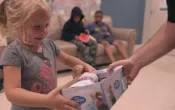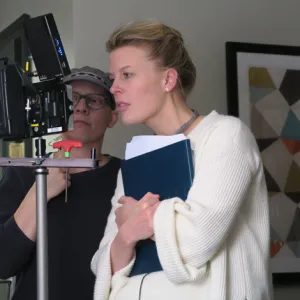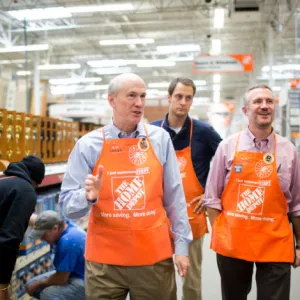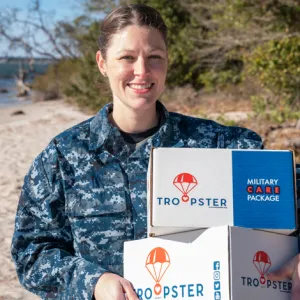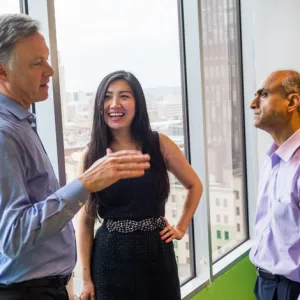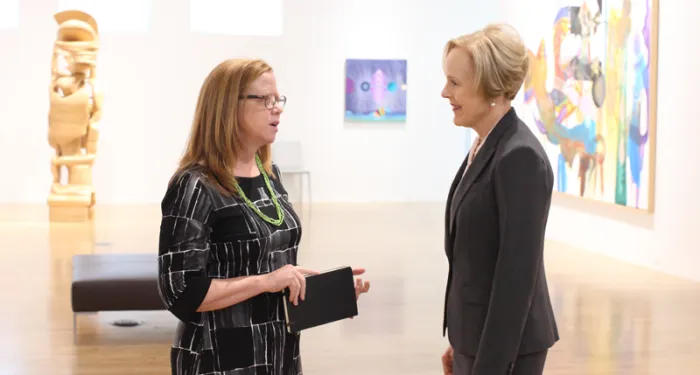
Ted Grossnickle And Laura MacDonald
Insights from Servants of Service
The Giving Institute is in the business of kindness, working to advance understanding of charitable giving to nonprofits that serve humanity.
A student once asked anthropologist Margaret Mead what was the earliest sign of ancient civilized society. She did not say tools, or art, or weapons. Rather, she said the first artifact indicating civilization was a healed thigh bone - evidence that others helped the injured until he could literally get back on his feet. Humane society begins when people care enough to give of themselves.
In our country and around the world, people have an innate desire to help others. There is generosity in so much we do - giving charitable gifts, contributing to a GoFundMe account, establishing a scholarship, buying a product because a portion of the proceeds help a worthy cause, attending a fundraising event, and on and on.
Before starting Crazy Good Turns, I didn't know much about the formal business of philanthropy. In addition to the terrific stories and amazing people we've featured over the last five years, this podcast has also been - and continues to be - a great learning experience for me. It has urged me to consider what drives generosity, why we are generous, why Americans are typically more generous than folks in other countries, and many other questions with complex, multilayered answers.
FRANK BLAKE: So, Ted and Laura, welcome to the show.
LAURA MACDONALD: Thank you, Frank.
TED GROSSNICKLE: Happy to be here.
FRANK BLAKE: Yeah. Laura, let me start with you, because I know that as the chair of Giving USA Foundation, you're responsible for publishing an annual report called Giving USA. Would you give some background to the report, and maybe some of the interesting findings from this year's version?
LAURA MACDONALD: Sure. I'll try not to take up the remainder of the podcast doing that. It's a topic near and dear to my heart. So, Giving USA is the annual report on the sources and uses of philanthropy in America. It's been published for, now, 66 years.
FRANK BLAKE: Wow.
LAURA MACDONALD: So, it's this amazing, longitudinal data source that really helps us see how philanthropy reacts and responds in different social or economic conditions over time. I think that's probably the greatest value, is this longitudinal data source. It's published by Giving USA, which is the public service initiative of The Giving Institute. For decades, we have retained the Lilly Family School of Philanthropy at Indiana University to do the research and writing. So, it's a very strong partnership between Giving USA and the good people at the Lilly Family School of Philanthropy. Each year, the report, which is, by the way, a 400 page book, and I know, Frank, you're going to take that to the beach for your next beach read.
FRANK BLAKE: So, now I'm set for the weekend.
LAURA MACDONALD: Basically, it looks at the four sources of giving. So, we talk about giving by individuals, foundations, corporations, and via bequest, which after all, is individuals making decisions about what'll happen to their resources after their lifetime. It looks at nine recipient sectors. Religion, education, human services, foundation, something nobody understands called public society benefit. We can unpack that if you want. Health, international affairs, arts and culture, and giving to the environment, and then animals. So, it really takes a look at who's giving, making charitable gifts, and who's receiving those charitable gifts. This year, we looked at giving in 2020. So, we always look at the previous year's giving. And found that Americans contributed $471 billion for nonprofit organizations.
FRANK BLAKE: Wow.
LAURA MACDONALD: So, that makes it a significant portion of our economy. It's about two percent of GDP. It's a big part of our economy. It alone is larger than the economy of some Scandinavian countries. Our team had a little fun with this one year. It's greater than the number of trees in the Amazon, for example, just to give it some context. Just about equal to the amount of beer, cans, pints of beer, consumed in America.
FRANK BLAKE: Okay. Yeah. Yeah. Lots of different perspectives.
LAURA MACDONALD: We can also find correlations.
FRANK BLAKE: Yeah.
LAURA MACDONALD: The other thing we found is that despite all of the disruptions, including a couple of quarters in which we experienced recessionary conditions, clearly, the inability of nonprofit organizations to hold galas, or runs, or walks, or rides, that charitable giving increased five percent from 2019 to 2020. We were pleased with that. That's right at close to what the average growth is on a year-to-year basis, in current dollar terms. There were some real strengths, some of it having to do with the way the market rebounded at the end of the year. That really influences giving by individuals and giving from foundations. There were some weaknesses, as well. Corporate giving actually declined, despite all of the pronouncements from corporations about their response to the pandemic.
FRANK BLAKE: Interesting.
LAURA MACDONALD: Corporate pre-tax profits declined. Corporate giving declined even more. Corporate giving remains less than one percent of corporate pre-tax profits. There was a day when a gentleman named Ken Dayton - The Dayton family founded what later became Target stores. He used to advocate that corporations should give five percent of corporate pre-tax profits, that it was good for the community, but that it was good business, as well. We're far from that today. There's some other idiosyncrasies in the data that maybe we'll unpack as we have our conversation today.
FRANK BLAKE: So, Laura, did you see anything, were there changes in terms of more individuals giving smaller amounts? I mean, more involvement? Because I would have thought that COVID would galvanize folks more.
LAURA MACDONALD: That's a really interesting question. Giving USA is something of an almanac, as well. So, we pull in lots of other research that's done around the country by credible sources. One is called The Fundraising Effectiveness Project. They actually come out with quarterly report on what they believe is happening in charitable giving. They came out and said that, yes, there was an increase in the number of households that participated in charitable giving in 2020. In some areas, it's declined that it's as few as 56% of American households that give in any given year, 90% of high net worth households, 56% overall. It's been declining over time. That's a concern.
FRANK BLAKE: Interesting.
LAURA MACDONALD: We know that it's not the same 56% of households, from a year-to-year basis. It's a dynamic shifting group of households. What we think is that those who could lean into charitable giving in 2020 did. I know we had clients who, shortly after the stimulus checks were released, they were getting gifts of $1,200. It was clearly a household that said, "I'm doing okay. I can share this money with the food bank, or the domestic violence shelter," or what have you. So, there is some evidence, mostly from that Fundraising Effectiveness Project report, that the percentage of households that participate did bump back up again in 2020.
FRANK BLAKE: You're right. We could spend the whole podcast going through this data. Did you see a shift to online giving, or are you able to measure whether there's more online giving than in the past?
LAURA MACDONALD: Indeed. Ted, I know this is something that you track in your firm, as well. In each chapter, there's a fundraising data processor called Blackbaud. They have a product called Raiser's Edge, which many, many, many nonprofits across the country use as their CRM for charitable giving. So, they come out with an annual index, the Blackbaud Index, and they will tell you, based on the data that they process, what percentage of gifts were given online versus through other ways. They saw a big spike of growth in 2020, some of which was driven by generosity, and some of which was just driven by logistics.
FRANK BLAKE: Right.
LAURA MACDONALD: People weren't going to the gala and bringing their checkbooks. So, online was where giving had to transfer, if it wasn't already there.
FRANK BLAKE: So, this is a good time, Ted, to pull you into this conversation and ask, because I'm sure you've looked at the report, was there anything that caught your eye, any particular change that you say, "Gee, this is interesting?"
TED GROSSNICKLE: Yeah. I share with Laura the danger inherent here is I could go down a rabbit hole and talk for an hour on this. Just as one piece of the bandwidth among recipient sectors or organizations, if you look at arts and culture, I think they had one of the larger increases in online giving, something like a seven or 10% increase in the last year. I think Laura would agree with this, is that over the last 10 to 20 years, you've seen a reasonably steady march forward and an increase in the amount of online activity, online giving, that's underway. It's clearly a big, big part of what people find as an easier way to give.
I guess the last thing I'd say is if you think about Giving Tuesday, or about all the giving days that various colleges, and universities, and other nonprofits have, many people are finding that even if they still write a traditional check, or do some other form of giving, that online giving hasn't replaced what they're doing, it's more of an add-on. I don't know. Laura, would you agree with that?
LAURA MACDONALD: I do think that it's a point of entry for many new and younger donors. It's very valuable in that regard. I do think that donors of every generation do use it for convenience for some of their transactions, while maintaining traditional ways of giving, whether it was writing a check. I mean, imagine somebody from Gen X or Gen Z having a checkbook, knowing what a stamp is. So, it's particularly, I think, an essential opportunity for the younger generations of donors in particular. But then there are other things like qualifying charitable distributions from your retirement assets that are never going to go online. Those are just transactions that happen in other ways.
FRANK BLAKE: Right. So, let me ask, moving from the report just to each of your assessments of the philanthropic world, let me start with a challenging question, which is … Because you have spent most of your professional careers in this space of helping people raise money. What do we get wrong? What do nonprofits typically get wrong about fundraising? What do donors who get these requests, what do we get wrong about this space?
LAURA MACDONALD: I think one thing that we can, and must, do a better job with is nurturing the relationship between the donor and the nonprofit. In usual circumstances, only 20% of donors who make a first gift to an organization will ever make a second gift to that organization. Think about that from a business perspective.
FRANK BLAKE: I'm shocked by that.
LAURA MACDONALD: Customer acquisition.
FRANK BLAKE: Yeah.
LAURA MACDONALD: Donor acquisition is the most expensive part of fundraising, as it is with many models. If you're only retaining 20% of those first-time donors, it's adding expense and inefficiencies. Some of it has to do with nonprofit organizations that could do a better job of nurturing those relationships. Some of it has to do with also, perhaps, educating donors who - at the end of the day, it's their money. It's their choice. But if they picked a few charities and really leaned into them and gave to them consistently rather than sprinkling their money around from year to year, I think that we'd see a more efficient nonprofit sector.
It also does bring up though the myth, the overhead myth. Overhead is not an effective measure of a nonprofit organization's impact. So, I wish that people would get away from looking solely at the cost-per-dollar raised or the proportion of funds that go to administration. I'll give you a good example. Let's say that an organization has really worked to beat down their overhead. They have low overhead. As a result, they have lax financial controls because they've cut staff from their business office, which means they don't have great security, data security, for example. Those aren't things that we would wish upon a for-profit enterprise. So, that's why I say another thing that we need to get away from is the overhead myth.
FRANK BLAKE: We had Dan Pallotta on as a guest of the podcast, and he makes that point with great passion, that it's the wrong metric.
TED GROSSNICKLE: Yes. He does. Yeah.
FRANK BLAKE: Ted, what do you think? What have we gotten wrong?
TED GROSSNICKLE: Well, I think this piggybacks a little bit on what Laura started with. I think we don't do the kind of job that we could do, among nonprofits, in telling the stories, finding our voice, however you want to call it. There are many nonprofits that assume because they can tell you how many things happened or how many outputs there were, that there's a story there that will motivate a person to make a gift. Oftentimes, it's not the outputs, it's the outcomes. People want to have something in which to believe, and we don't tell our story in a compelling way. It's remarkable to me how often we have to say … I suspect Laura and our other colleagues deal with this … is to, frankly, empower or encourage our clients to soar with the vision and also marry that up with the statistics. So, do something that compels people to pay attention. Don't be afraid to be a good storyteller.
The other thing that I think is always a bit dangerous for us in this work, and certainly among nonprofits, is to assume that all donors are … Donors are not monolithic. I mean, we really take a risk when we say, "Here's what donors will do." The Giving USA report is a stupendous resource, but the heart of it, for many of us, is that it helps you break down, to some extent, what is this enormous, large element of American society. In our nonprofits, we need to do a better job of having the same thinking, to say, "Yeah. We have some people who are 70 years old, are very generous, and have been for years. We have some people that are 22 years old. Let's think about where they are in their lives. Let's think about them as a different group with many segments. One size does not fit all." Those are two points.
FRANK BLAKE: So, as young as both of you are, you've been involved in this space for a while now. What's changed the most over your time?
TED GROSSNICKLE: I would throw out this point. I think that the impulse to help, the impulse to be generous, the impulse to see somebody who is in your town or your neighborhood and you want to help them, is there. It's always been there. Incidentally, in work that my colleagues and I have done in Europe and other parts of the world, that impulse to help a fellow human being is also there. I think it's made manifest in America in some better and stronger ways. First and foremost, from when I started this thousands of years ago, the impulse to help is there. Laura alluded to some changes in giving habits, and there are. There are also changes in how people volunteer.
There are a lot of people writing things nowadays that relate, I think, to what Laura and I and our colleagues see in giving and volunteering. These things connect to how Americans feel about themselves and their country. I don't think it's a coincidence, for example, that among the changes in giving and volunteering, you've seen significant changes sociologically in how people classify themselves in terms of religion, the rise of what they call the nones, the non-designations. I think religion has an impact on it. There are a lot of things to unpack in this, but generally speaking, I think people want to help, and they want to volunteer. They're finding a lot of new ways to do it, and maybe some ways that don't get fully measured. I'd start with that. Laura, what do you think? Am I way off?
LAURA MACDONALD: No. I'd pick up on several threads there, Ted. Yes. When I started my career, giving to religion represented more than half of all charitable giving. Religion received more than half, about 55%, of all charitable gifts. This is giving to almost exclusively houses of worship, of any faith. We've known that there's a strong correlation between active participation worship, somebody who attends worship three out of four weeks a month. There's a strong correlation between that active participation in worship and charitable giving. So, with what we call the rise of the nones, today, if you do a survey, and you ask Americans what their religious affiliation is, the highest response will be none. We've really seen the rise of the nones.
There's one study that suggests that since the turn of this century, about 20 million households have stopped actively participating in religion, about 20 million households have stopped actively participating in charitable giving. It's not the same 20 million households, we don't believe, and we can't say cause and effect, but certainly, there's a troublesome correlation there. If the next generation is not going to learn their charitable giving habits in the pew, then how will we tap into that generosity? Ted used the word, and I think, Frank, at the very top, you talk about generosity. Giving USA measures formal charitable giving to 501(c)(3) organizations. There are a lot of other ways that Americans express generosity, that people around the world express generosity, whether it is a GoFundMe, leaving a big tip at a struggling mom and pop diner, buying a product because you know a portion of the purchase is going to go to a worthy cause. There are lots of ways that generosity is expressed. I think we under-capture that in Giving USA.
FRANK BLAKE: Great point.
LAURA MACDONALD: Because I think particularly for the everyday household, and frankly, for minority households, where things like mutual aid societies have existed for a long time, and we're only coming to recognize the generosity that they represent … So, I think that there are some things that we under-represent. A third thing I'll say, at the risk of offending anyone, I think we need to be careful about buying into a myth of American exceptionalism here. In America, because we're a society of individuals, this wonderful practice of philanthropy has grown, and we have formalized that, and we've created a profession around it, and all sorts of technology and tools, and we measure it. That's one of the primary ways that Americans have chosen to express their generosity.
But let me tell you a story from when I was doing some work with the World office of the YWCA. I used to stay in a retreat center in Geneva because it was affordable. A lot of the delegations from the developing world would also stay at that retreat center. So, one morning, I found myself having breakfast with the minister of education from the Ivory Coast. Fascinating conversation ensued. When he asked what I do for a living, and I explained that I worked in philanthropy, he said to me, "Oh, we don't have a lot of that in my country." The conversation continued. At some point, he pointed out that he paid the school fees for about 20 kids from his home village. I said to him, "Sir, that's philanthropy." He said, "Oh, no. That's just what we do."
FRANK BLAKE: Oh, that's great.
LAURA MACDONALD: So, I think that when we look at how we measure this, we need to be careful about recognizing all forms of generosity.
FRANK BLAKE: That's great. That's very, very well said. There are a lot of things that aren't captured. I think that's important to recognize.
Because you all help a lot of folks who are running nonprofits, and we have a lot of people who listen who are involved in nonprofits in different ways, what do you most commonly give as advice? Where do you typically start with advice on how you more effectively unlock generosity?
LAURA MACDONALD: I think a couple of things, Frank. One is that for many board members, for example, they're comfortable approaching a foundation or a corporation and asking them to make a gift, but they're much less comfortable approaching an individual donor, the person down the street or in the office down the hall. Yet, we know that of that $471 billion, 69% of it, almost $325 billion, was given by individual donors, that another $42 billion was given by individuals through their estates, and that about half of the money from foundations, or another $44 billion, is coming from donor-advised funds and closely held family foundations, so individuals making decisions about what used to be their own money.
We really need to help nonprofit organizations and their volunteer corps get outside of their comfort zone a little bit and really think about, "How do we invite more individual donors to be a part of what we're doing here?" Because that's the lion's share of philanthropy. That's the really sustainable part of philanthropy, as well. You can project how many you'll retain. Because if you retain them the first time, now they're sticky. Now they're going to stick with you for longer. So, I think that's one. Let's focus on individual donors. The other is that just like you ran a big enterprise, and I'm sure that there were times when you were beholden to that quarterly earnings report, lived in a 90 day world, nonprofits can have the same concern.
So, we know that high net worth households tend to be the largest donor. Philanthropy has become top heavy. Three percent of American households represent something like 65% of all of the dollars. There's both cause and effect there. What we see is that because many nonprofits are just so focused on making this year's goals, frankly, that there may be some performance-based compensation for the development officers, et cetera, "We've got to make this year's goals," but next decade's donors are giving $250 now. They're not getting the attention that they need if they're going to stick with the organization as they are successful in their careers, and build wealth, and have the capacity to make bigger gifts. Nonprofits also need to break free of that short-term time horizon.
FRANK BLAKE: Excellent. Excellent. Ted?
TED GROSSNICKLE: I think Laura has covered those two points really persuasively. I would go in a slightly different direction, and that is to say if we're thinking about the things that volunteers can do, that they need to bear in mind, what's the advice? Many times, we're telling them what is the equivalent of an old expression from tailors, which is, measure twice and cut once. Think about this, prepare for it, and you're likely to do a better job. There's often a natural enthusiasm. "Let's go out and do this immediately." What can we do to really make sure we're going to get the best result? Think about it for a moment.
From a strictly personal basis, if you're a volunteer with a nonprofit, be prepared to lead. That usually means being prepared to make an investment first. Many times, the advice that we might give in this regard is already understood by the nonprofit, but other times, it's not. The volunteers, especially board members, need to understand that many prospective donors are going to look at that cause and take the measure of it by the degree of passion and investment that board member has made. So, if you're a volunteer, be prepared to lead, and be prepared to be in the vanguard of supporting whatever effort that is, whether it's a campaign or the annual fund.
FRANK BLAKE: What, from your experience, are there things that you see that are barriers to generosity and people giving that we don't pay enough attention to, or that you say, "Gee, we can help people get over these barriers?"
TED GROSSNICKLE: One is something we talked about a few minutes ago. I think for many people, a route of first access is online giving. It's easier. It's certainly less of a barrier than asking a 20 year old to find a stamp. I think a larger barrier, and to some extent, it's one that nonprofits really have recognized and know they need to work on, is when one of the nonprofits falls down, when there's a trust issue, when there's something that occurs with a leader in some organization. There are many people who, perhaps less practiced in giving, see that as a reason to not give to a cause that is perfectly fine, is entirely run on a best practice measure, and can do a heck of a lot of good in their hometown. They draw the wrong lesson.
I guess at a micro-level, yes, there are probably a lot of ways that we can make it easier for people to give. 30 years ago, the radical idea was to include a business reply paid envelope with direct mail. There are those mechanical things. I think sociologically, or from a leadership standpoint, I would like to see more people in the nonprofit sector giving their voices to what it means about having integrity in nonprofit leadership, and in having a stronger voice for how so many of them really do a stunningly good job. They hide their light under a bushel. So, those are the first thoughts that come to mind for me.
LAURA MACDONALD: The few bad apples do tend to grab the headlines rather than the 99.5% of organizations that are well run and doing great work. The other thing is that the mega gifts get the headlines. So, MacKenzie Scott gave something like $5.6 billion at the end of 2020. By the way, giving by individuals grew by $7.1 billion in 2020. So, you can do the math there and see the influence of those outsized gifts on the top line count of philanthropy. So, when there's a donor whose capacity, for whom a generous gift is $50, how do we tell a story to them about the impact and importance of that gift? How do we inspire them to participate in this? Because I think philanthropy that's more democratic is better for the social fabric of our country.
FRANK BLAKE: That's great. That's a great comment. This is fascinating. I mean, you all have such great insights into this space. Let me ask you a personal question. I ask this on each episode. Who has done a crazy good turn for you? What was it?
LAURA MACDONALD: I'll cite two, one from a business perspective and the other from the philanthropic sector. So, from a business perspective, I started this business back in the year 2000. I had a daughter who was in her first year of college. I had a steady job with a regular paycheck and great retirement benefits, and walked away from all that to start this business.
FRANK BLAKE: This business is your consulting and helping people raise money.
LAURA MACDONALD: Benefactor Group, the consulting firm that I've led for the last 21 years now. Like many people, I had … I hope I can say this. I had an oh shit moment. "What have I done? I need a mentor." So, there's a woman in my community, in central Ohio, she's a car dealer. Car dealers have pretty sharp elbows, you might have noticed. She runs a heck of a business. It's the largest European car dealership, certainly, in the Midwest. Runs a great business. I wrote a note to her. I've been having breakfast with her about every six weeks for the last 20 years, including earlier this week. She just has been enormously generous to me with her guidance and advice. Philanthropy is a business of kindness and people doing their best. Sometimes she gives me a little bit more spine when I need it, because it's also a business. Making payroll every month is what my team expects. So, Barbara Fergus is the first one, I'd say.
FRANK BLAKE: Perfect. Yep.
LAURA MACDONALD: The other is Dr. Musimbi Kanyoro. So, Musimbi was the general secretary of the World office of the YWCA. I got a call from her six weeks after I'd started the business, and had an opportunity to serve as counsel to the YWCA for about seven years, traveling to Geneva regularly and other corners of the globe, talking about how they would support an endowment to empower the lives of women and girls around the world. She then became a grant maker with a $30 million annual giving portfolio, and then ended her career as CEO of the Global Fund for Women. I had the great privilege of accompanying Musimbi on many parts of that journey and seeing a broader global view of philanthropy than I might otherwise ever have had the opportunity to see. I'm enormously grateful to Musimbi, as well.
FRANK BLAKE: Fantastic. Terrific. So, Ted, anybody done a crazy good turn for you?
TED GROSSNICKLE: If it's okay with you, Frank, I want to do two, as well.
FRANK BLAKE: Yeah.
TED GROSSNICKLE: The first one is a person named Gene Henderson. Gene is a retired attorney in Indiana, was, in the early 1980s, not only a very successful attorney but a leading trustee at the college which I had come to work. I was all of 32 years old as an entirely wet behind the ears, very green, vice president for advancement. I sat down with Gene, who was a campaign chair for the campaign that I had been brought in to help lead as a staff person. Gene was, I think, three years into a five year period as that chair. As you might guess, as a volunteer, you can get fired. He had every reason at that stage to say, "Let one of the vice chairs take over." But what he did, in large measure, and we've talked about this since then, he re-upped when he didn't have to, in countless ways, took me under his wing, and taught me not only the heart of storytelling and some of the things that Laura might have talked about with you today, but taught me a lot of things just about how to conduct yourself.
He didn't have to do that. He certainly didn't have the time for it, but he did it. That was a crazy good turn. The other one occurred in the 1990s. I was affiliated with an organization, and it was a college. They had a student, who was quite a good student and an athlete, who was diagnosed with an acute form of leukemia. This young man came from very few resources. He was lucky to be in school. It was tough. His parents, who loved him very much, did not have much money. This young man found himself in a limited airflow room, and the rigorous treatment for the acute form of leukemia, and within a few months, the hospital bills totaled, I think, if I remember correctly, $300,000 to $400,000. A couple of people associated with that college, friends, alums, came to me and said, "We'd like to help out on those expenses, but we want to do it in a way that no one will know about."
FRANK BLAKE: Ah.
TED GROSSNICKLE: It took some doing, but we found a way. Those people paid all or most of that set of hospital bills and to this day, are not known to that young man who we helped.
FRANK BLAKE: Wow. What a great story.
TED GROSSNICKLE: And went on to become a doctor and has saved many lives. It reminds me that some of the best things happen when no one gives a damn about the credit.
FRANK BLAKE: Wow. What a wonderful story, Ted. That's fantastic. That's terrific. I can't thank both of you enough. What a fascinating discussion. Thank you for what you've dedicated your careers to doing. Just as you were saying, Laura, at the start, over $400 billion, this is a huge part of the economy. It doesn't get the attention that it deserves. Frankly, having people who are really thoughtful professionals helping others think their way through this, what a great thing to dedicate your careers to. So, thank you for that. I want to close by giving you just an opportunity. If people want to, you know, whether you've got a social media platform, or some place, "Hey, I want to get in touch with Laura or Ted. I want to send them a note," what's the best way to do that?
LAURA MACDONALD: Great. I would say for me, our website is benefactorgroup.com. Among other things, we do an annual infographic that takes that 400 page book and boils it down toa broadside. If you'd like the CliffsNotes version, you can sign up, and we'll be happy to share it with you at that website. I'm also on LinkedIn, LAURA MACDONALD, M-A-C-D-O-N-A-L-D.
FRANK BLAKE: Terrific. Ted?
TED GROSSNICKLE: Yeah. Thanks very much. I'm at Johnson, Grossnickle and Associates. So, the website is jgacounsel.com. That's C-O-U-N-S-E-L. Frank, let me thank you for, one, not only making this painless but making this really enjoyable.
FRANK BLAKE: Well, I hope you weren't anticipating pain.
TED GROSSNICKLE: Well, I don't know. You made it fun. Thank you.
FRANK BLAKE: Yeah. Well, this has been fascinating. I love this. This has been just a fascinating discussion. So, thank you both very much.
LAURA MACDONALD: Thanks for shining a light on the sector, Frank.
The Business of Kindness
Our guests for this episode are two people who've spent a lot of time, and most of their careers, thinking about and working within professional philanthropy.
Ted Grossnickle And Laura MacDonald are both active thought leaders in the world of generosity. Ted recently stepped down from his post as chair of The Giving Institute, a trade association whose mission is "shared intelligence for the greater good." Laura is chair of the Giving USA Foundation, the public service initiative of The Giving Institute which produces an annual report examining how philanthropy reacts and responds in different social or economic conditions over time.
Each of these thoughtful professionals has spent years helping charitable organizations better understand and improve philanthropic giving, so that they may raise more money to help more people and causes.
Grasping the Impacts of Giving
In 2020, Americans contributed $471 billion to nonprofit organizations. Understanding and advancing that generosity is no small task.
In this episode, Ted and Laura will tell us:
- Which philanthropic sector saw the biggest increase in online giving, and which sector decreased despite promises of support during the pandemic
- What might be contributing to the decline in percentage of households that donate
- The best advice for people who want to donate
- What we are under-counting when we measure philanthropic giving
